Director(s) Hitoshi Akamatsu Programmer(s) Nobuhiro Matsuoka Initial release date 26 September 1986 | Producer(s) Akihiko Nagata Artist(s) Noriyasu Togakushi | |
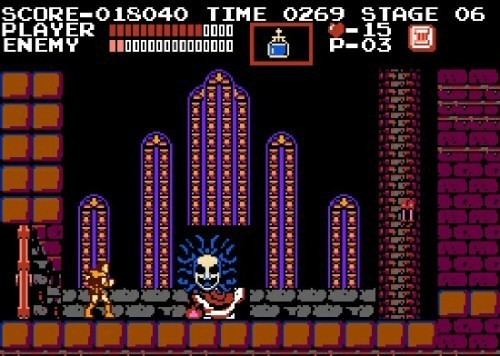 | ||
Composer(s) Kinuyo YamashitaSatoe Terashima Release date(s) September 26, 1986Famicom Disk SystemJP: September 26, 1986NES/FamicomNA: May 1, 1987PAL: December 19, 1988JP: February 5, 1993PlayChoice-10 & Nintendo VS. SystemNA: 1987Commodore 64, Amiga & DOSNA: 1990PAL: 1990 (C64 version only)Mobile phoneJP: 2002NA: July 7, 2004PAL: 2004Microsoft WindowsNA: November 16, 2002Game Boy AdvanceJP: August 10, 2004NA: October 25, 2004PAL: January 7, 2005AU: November 24, 2005 Genres Action game, Platform game Similar Castlevania games, Konami games, Platform games | ||
Castlevania, known in Japan as Akumajou Dracula (悪魔城ドラキュラ, Akumajō Dorakyura, officially translated Devil's Castle Dracula), is an action-platformer video game developed and published by Konami for the Family Computer Disk System video game console in Japan in September 1986. It was ported to cartridge format and released in North America for the Nintendo Entertainment System (NES) in May 1987 followed by a European release in 1988.
Contents
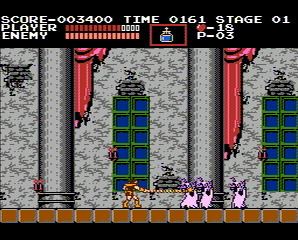
The game takes place in the year 1691 where players control Simon Belmont who is tasked with defeating the vampire Dracula. It was re-released for the Family Computer (FC) in cartridge format in 1993. It is the first game in Konami's Castlevania video game series; it was followed by two more NES games titled Castlevania II: Simon's Quest (released for the NES in 1988) and Castlevania III: Dracula's Curse (1989). A fourth game, retelling the events of the original, was released for the Super NES and titled Super Castlevania IV.
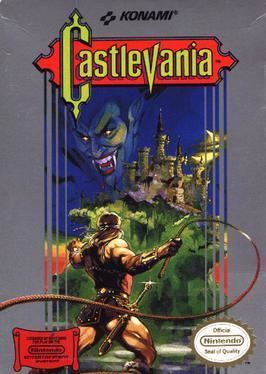
Castlevania was positively received and financially successful. It is considered an NES classic by PC World, while Nintendo Power and Game Informer ranked it in their best video games list (at 22 and 48 respectively). IGN ranked it 19 among their favourite NES games.
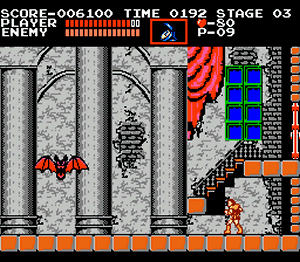
Plot
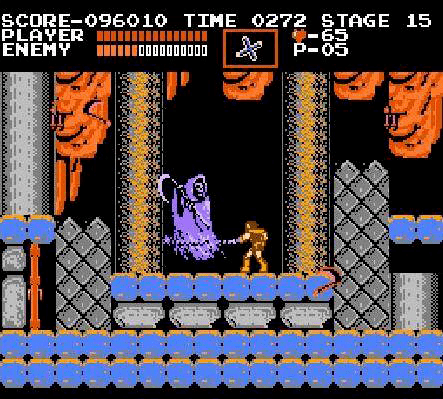
Castlevania puts players in control of Simon Belmont as he travels through Count Dracula's castle, which emerges every 100 years. Simon battles numerous bosses along his way, including Frankenstein's monster, Igor, a pair of Mummy Men, the Phantom Bat, Queen Medusa, the Grim Reaper, and Count Dracula himself. Simon encounters Dracula in his lair and defeats him. He escapes the castle as it crumbles apart and credits roll. The credits feature fake names in homage to classic horror film actors such as Bela Lugosi, Boris Karloff, Max Schreck, and Christopher Lee.
Gameplay
Castlevania uses platform gameplay and is divided into six blocks of three stages each, for a total of 18 stages. Simon can move, jump, crouch, climb stairs, and use a magic whip as his primary combat weapon. When the player presses the button to crack the whip, there is a short delay before Simon actually does so. The player begins the game with three lives, and must complete the current block of stages before a timer runs out. Simon has a health meter, which decreases whenever he is attacked by an enemy or projectile; if the meter is fully depleted, he falls into a pit, or the timer reaches zero, the player loses one life. Hidden food items restore health, and bonus lives are earned at certain score thresholds. A boss character must be defeated at the end of each block in order to advance to the next one; the ultimate goal is to defeat the Count at the end of Stage 18, triggering the collapse of his castle.
Throughout the game, the player can find and use various backup weapons. However, only one such weapon can be carried at a time, and it is lost if the player loses a life. Backup weapons require hearts for their use, which can be found or taken from defeated enemies. Other hidden items include point bonuses, temporary invincibility, whip upgrades (3 levels total), instant destruction of all on-screen enemies, and double/triple use of the backup weapon.
When all lives are lost, the player may continue from the start of the block in which the game ended.
Development
Akumajō Dracula was developed and published by Konami for the Family Computer Disk System in 1986. Due to its success in Japan, it was released in cartridge format for the Nintendo Entertainment System (NES) under the title of Castlevania in 1987 and 1988 in North America and Europe respectively, and rereleased in cartridge format for the Japanese Famicom under its original title in 1993. The international name of Castlevania was the result of Konami of America senior vice president Emil Heidkamp's discomfort with the religious connotations of the title Akumajō Dracula, which he believed translated as "Dracula Satanic Castle." Castlevania was one of the first major platform games on the NES and a part of an unofficial second wave of video games for the NES. Its release coincided with the 90th anniversary of Bram Stoker's Dracula.
A game also titled Akumajō Dracula was developed for the MSX2 simultaneously. It was released a month after the Disk System game. It was released in Europe under the title Vampire Killer where it was the first game in the series to be released. The MSX2 version featured different areas and a different structure.
Versions and re-releases
Castlevania has been ported to a variety of different video game consoles, handheld game consoles, home computer systems, and mobile phones. The NES release of the game was adapted for video arcades both as a part of Nintendo's Play Choice 10 series and (with the addition of a two-player competitive play mode) the Nintendo Vs. System. In 1990, versions of the game were released for the IBM, the Commodore 64 (both developed by Unlimited Software), and the Commodore Amiga (developed by Novotrade). A ROM version of the game was released for the Japanese Family Computer in 1993. The port omitted the name registration screen from the original Famicom version (as well as saving) and included an "Easy" mode. In 2002, Konami released the first three NES Castlevania games for Windows as Konami Collector's Series: Castlevania & Contra.[1] This was later added to GameTap in 2006. Upstart Games ported a mobile phone version of the game from the original Japanese mobile game in 2002. That version was upgraded in 2004 with improved graphics, and was subsequently released in North America and Europe for multiple handsets. A third mobile phone version was produced in late 2004, with even better graphics, but has only been released in Japan as of early 2005. In 2004, Castlevania was released for the Game Boy Advance as part of the Classic NES Series published by Nintendo. The mock ending credits of the game, which are mostly puns on the names of veteran horror movie stars, were removed in this version. However, it does have the stage select feature. It has been released for both the Wii, Nintendo 3DS and Wii U Virtual Console services in 2007, 2012 and 2013 respectively. These versions are emulations of the original NES game. The 3DS version launched in North America on April 4, 2013 to coincide with the release of Castlevania: Lords of Shadow – Mirror of Fate.
Reception
Since its original release, Castlevania has received generally positive reception. It sold impressively and was considered a classic by Retro Gamer and IGN. It was rated the 22nd best game made on a Nintendo System in Nintendo Power's Top 200 Games list in 2006. In August 2008, Nintendo Power listed it as the 14th best Nintendo Entertainment System video game. Game Informer ranked it the 48th best game ever made in 2001; the staff noted that its gameplay set a standard for the industry. IGN ranked it 19th on their list of the best NES games; the second and third Castlevania games were ranked 25th and 5th respectively. It was praised for its difficulty, gameplay, soundtrack, and visuals. GameZone ranked it as the eighth best Castlevania game. Robert Workman (an editor for GameZone) felt that the game had aged well and was a great value on the Wii Virtual Console. IGN's Lucas M. Thomas noted the relative realism of Castlevania's weapons versus "glowing flowers that let you throw bouncing fireballs." He also praised it for feeling scary while also not taking itself too seriously. The combination of these elements and others caused him to credit it as a "unique and wonderful" game and a game that made an impact on later Castlevania games. Retro Gamer called it one of the most enduring video games ever made. It attributed its quality less so to unique gameplay and more so to its more adult atmosphere and challenge. In his review of the Virtual Console version, IGN's Mark Birnbaum personally enjoyed its difficulty and design but noted that people who were quick to become frustrated would enjoy the Super NES sequel Super Castlevania IV better. 1UP.com's Kurt Kalata praised its level of difficulty and its realistic visual design. In Japan, video gaming magazine Famitsu scored Famicom version game a 34 / 40. Game Informer's Tim Turi claimed that the original Castlevania made the series a "legend" and called it the "essential Castlevania experience."
IGN's Colin Moriarty wrote a piece that discussed the idea that this game as well as other Castlevania titles were overshadowed by the 1997 Castlevania: Symphony of the Night which he considered the best title in the series. He cited this game's absence from IGN's top 100 games of all-time as well as the absence of the second and third Castlevanias from Game Informer's top 100 games of all-time list. He suggested that the reason this is the case is because of the NES games' high learning curve and difficulty level. He also felt that Symphony of the Night's influence on the series after its release caused people to forget about the NES games. He praised the Virtual Console for allowing players unfamiliar with these games to experience them more easily. IGN's Lucas M. Thomas included its 25th anniversary in a list of forgotten anniversaries which took place in 2011. He felt it odd that Castlevania had so many titles before its 25th anniversary and only one title during 2011.
The Classic NES Series re-release of the game was met with mixed to positive reception. It holds an average score of 74 and 70.92% at Metacritic and GameRankings respectively. IGN's Craig Harris ranked Castlevania as the best game in the second volume of Classic NES Series releases (which include Dr. Mario, Metroid, Castlevania, and Zelda II: The Adventure of Link). He also felt that it was worth playing despite the other three Castlevania games available for the Game Boy Advance. 1UP.com's Jeremy Parish felt that the game had become dated due to the relative limitations between Simon Belmont and later Castlevania characters such as Alucard and Soma Cruz. He also felt that it was too short. In spite of this he praised it for its hard-but-fair challenge and its audio and visuals. Benjamin Turner and Phil Theobald of GameSpy both felt the game had aged poorly; Phil however felt that it was easier for him to adapt to the controls than Ben.
